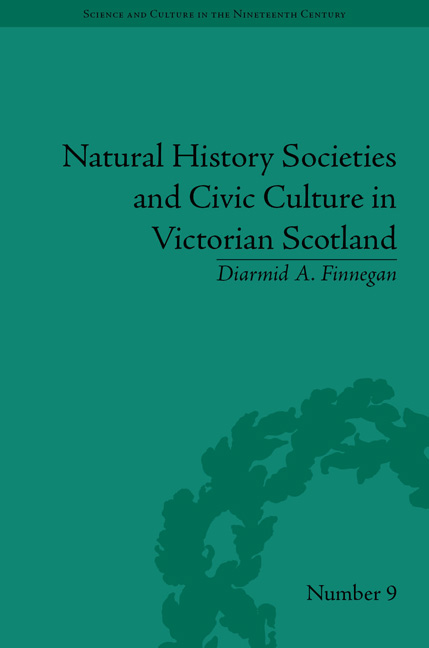Book contents
- Frontmatter
- CONTENTS
- Acknowledgements
- List of Figures and Tables
- Introduction
- 1 Founding Narratives
- 2 Fieldwork and Excursion Culture
- 3 Natural History and Civic Pride
- 4 Natural History and Self Culture
- 5 Organizing Subscriber Science
- 6 Scientific Motives and Civic Virtue
- Conclusion: Between Science and Civic Society
- Notes
- Works Cited
- Index
3 - Natural History and Civic Pride
- Frontmatter
- CONTENTS
- Acknowledgements
- List of Figures and Tables
- Introduction
- 1 Founding Narratives
- 2 Fieldwork and Excursion Culture
- 3 Natural History and Civic Pride
- 4 Natural History and Self Culture
- 5 Organizing Subscriber Science
- 6 Scientific Motives and Civic Virtue
- Conclusion: Between Science and Civic Society
- Notes
- Works Cited
- Index
Summary
The field excursion of the third annual meeting of the Northern Scientific and Literary Societies held in Banff in 1883 provided a public spectacle for the town. The Banffshire Journal recorded that:
By eight o'clock [on Saturday Morning] Low Street presented a scene of unwonted animation, hundreds of spectators having turned out and lined its pavements, while carriages in great variety of form and dimension, every one drawn by at least a pair of capital horses, were driven along smartly to take their places in the procession.
The rendezvous for the excursionists, the Fife Arms Hotel, provided a grand civic backdrop to the spectacle being adjacent to, and in architectural competition with, the Town House. Fieldwork, for all the accompanying rhetoric of escape from the town, could provide a ceremony that drew crowds and provoked, as the report testified, public excitement. What was more often considered an event organized for members of a natural history society became a public rite that transposed science into the language of civic pride and progress.
This chapter offers an account of the public lives of Scottish natural history societies in the civic realm and examines the ways in which their activities were orientated towards local civil society. The societies’ imprint on a local urban environment was registered in numerous ephemeral and more permanent ways. Here I investigate the various sites, occasions and advertising strategies by which the societies were made recognizable and accessible to a local public. The chapter's first section examines conversaziones and exhibitions. Society members regarded such events as useful for recruitment purposes and as a way of fulfilling educational goals. Yet conversaziones were defined not only by the organizers but also by the attendees. As a common cultural event, the meanings attached to conversaziones thus extended beyond those associated with the aims and objectives of natural history societies. The second section looks more closely at the fundraising strategies employed by the societies beyond the small income generated by regular entrance fees and annual subscriptions.
- Type
- Chapter
- Information
- Publisher: Pickering & ChattoFirst published in: 2014

